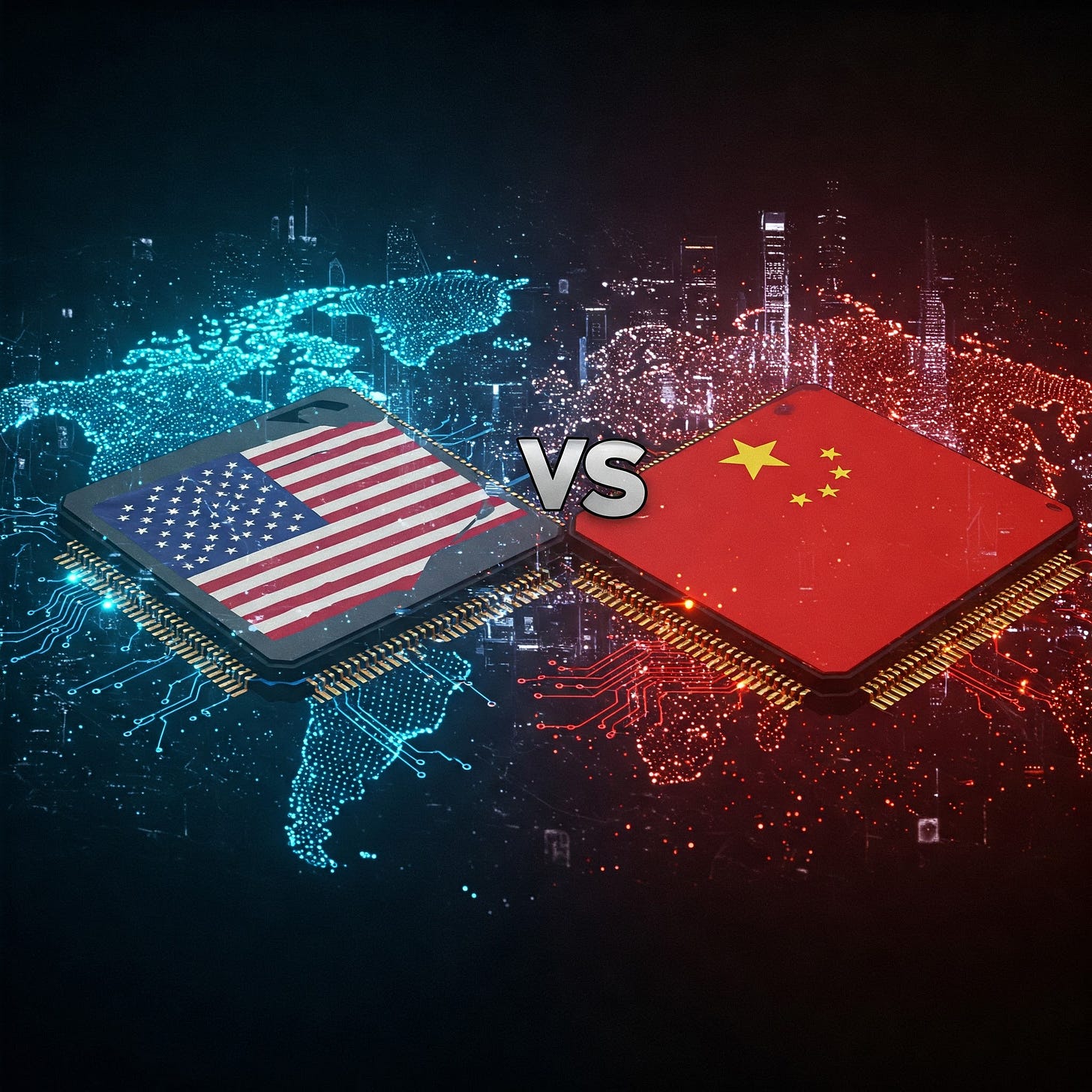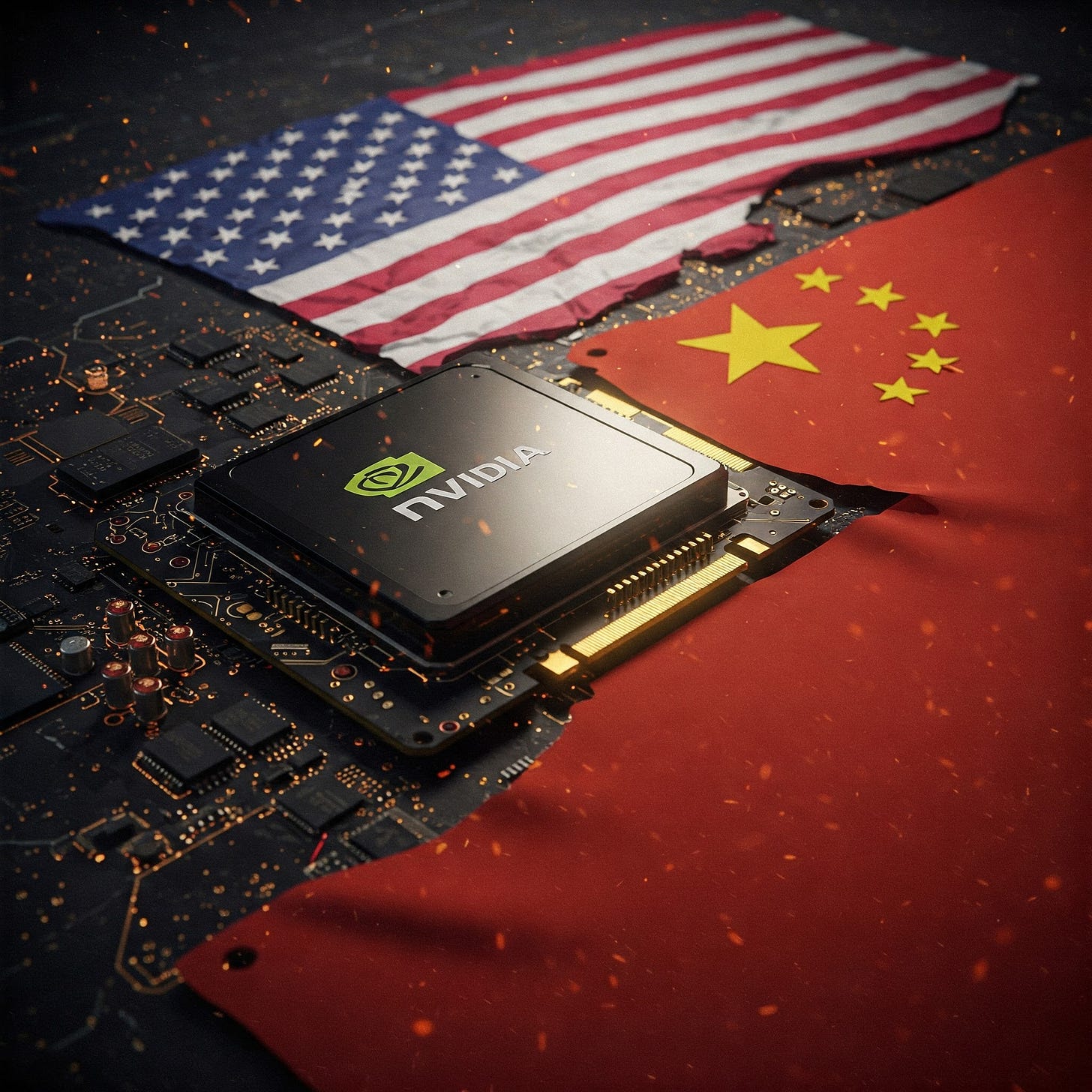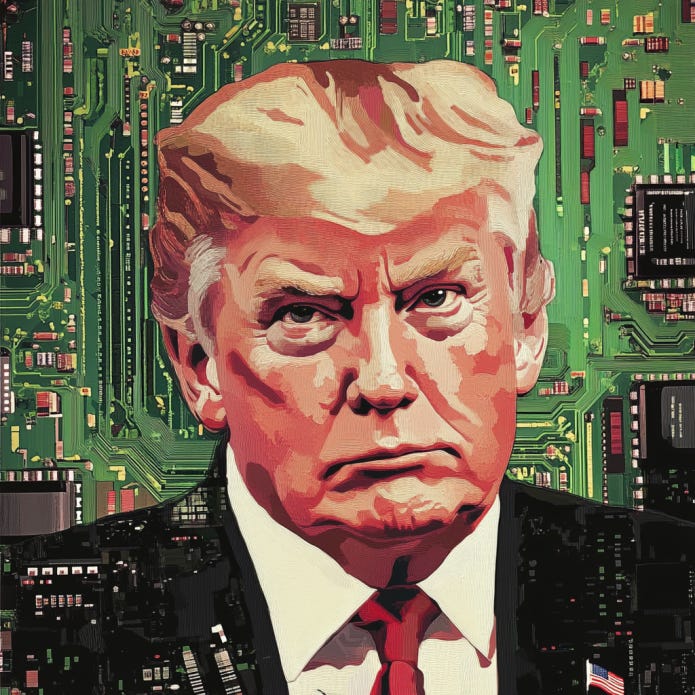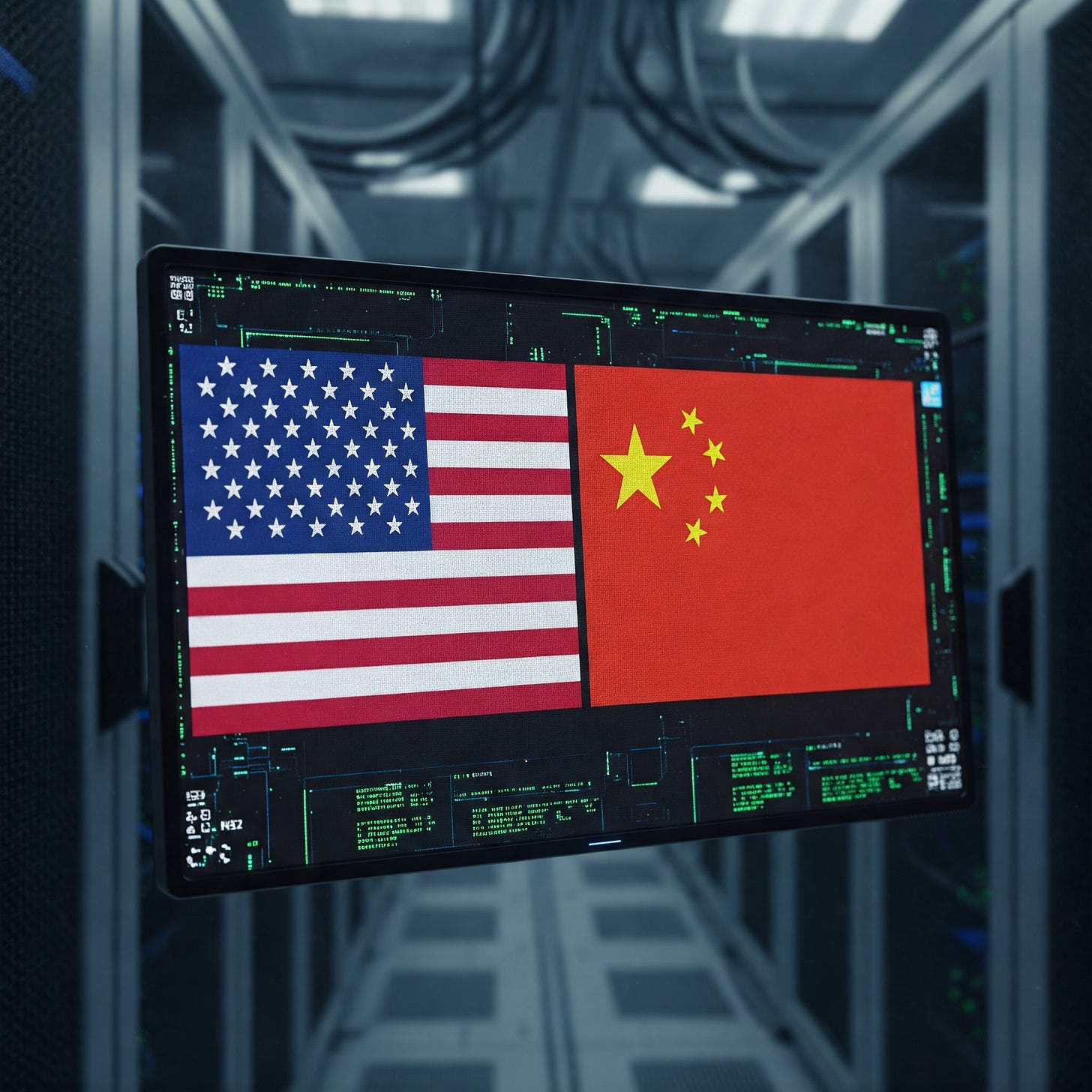2025 AI Chip Race: U.S. Export Controls on NVIDIA GPUs to China vs. Trump's Strategy (Game Theory Analysis)
What is the optimal strategy for the U.S. to maintain AI dominance over China?
Think the AI chip race couldn’t get any wilder? Welcome to 2025. On his way out, Biden forced an “AI Diffusion Rule” on January 13 that controls where advanced AI/HPC chips can be sent.
Now Trump’s in charge, and he’s threatening hefty tariffs on Taiwanese semiconductors, floating huge investments in domestic AI infrastructure, and mulling whether to hit China even harder with export controls.
Meanwhile, China’s got its own strategies—both official and under-the-table—to keep pace with the U.S. So what’s the optimal way for the U.S. to play this to avoid unforced errors (i.e. fumbling the AI lead)?
There are a variety of angles to think about this… Some think that we should have zero restrictions on AI chips to China because “they get them anyway” through workarounds (e.g. smuggling GPUs from Singapore) — these people believe controlling exports to China is futile for the U.S.
Preface: These are various stances people have re: selling chips to China vs. bans vs. partial bans, etc. A logical argument can be made for any of the positions… but it doesn’t mean that any will have the real-world outcome that the logic implies.
Example: Someone may argue that zero restrictions on NVIDIA sales to China will slow down China’s domestic chip manufacturing/industry. What might happen is the opposite: a Chinese company (e.g. Huawei) dissects NVIDIA chips at an accelerated rate and reverse-engineers to undercut NVIDIA’s competitiveness.
(That said, NVIDIA might be able to maintain its dominance more effectively with extra revenue extracted from the Chinese market via GPU sales. Nobody truly knows the outcome. If NVIDIA’s R&D is less efficient for a cycle or two than usual, Huawei or someone else could bridge the gap/catch up.)
A.) Logic for Zero Restrictions on NVIDIA GPUs to China
There are some hypothetical potential benefits that could emerge from this. China might become even more reliant on NVIDIA for AI advancement, may contribute more open-source breakthroughs (that benefit the U.S.), and may never catch NVIDIA with homegrown Chinese chipmakers.
If they do catch the U.S. (or get close), this could motivate U.S. companies to overtake China (such that the U.S. achieves some breakthrough under-pressure that they never otherwise would’ve). NVIDIA may also have an easier time tracking what architectures the Chinese are working on (based on requests for chip designs etc.).
China Ends Up with the GPUs Anyway: Even if the U.S. blocks sales, China can find workarounds (e.g., grey-market imports, third-party resellers). So why forfeit the revenue if it’s going to happen regardless?
Funding NVIDIA’s Next Leap: Selling directly to China pours cash into NVIDIA, which then invests that money into R&D, staying a step ahead of Chinese chipmakers. This strategy potentially keeps U.S. innovation in the lead.
“Open Source” Spillover: Many of China’s AI projects release papers, code, or ideas that anyone—including American labs—can study and improve. By letting them buy cutting-edge tech, we might indirectly benefit from whatever breakthroughs they make.
Slow Down Chinese Chip Independence: If China can easily purchase top-tier NVIDIA GPUs, it’s less urgent for them to develop their own high-end chips. That means fewer resources funneled into massive homegrown R&D efforts designed to replace U.S. technology.
B.) Logic for Partial Restrictions on NVIDIA GPUs to China
I think this is probably the smartest option. This doesn’t necessarily mean there won’t be new NVIDIA GPU shipments smuggled from Singapore to China… but it’s more of a hassle to do this and less tempting (because you can still get pretty good NVIDIA chips legally without the extra hoops).
Supply “Downgraded” Chips: Restrict the absolute best (e.g., the newest Blackwell GPUs), but still sell earlier or lightly throttled models. China remains reliant on U.S. gear, but won’t have the very latest.
Balanced Incentives: NVIDIA earns revenue from selling mid- or older-generation chips, which still funds R&D. Meanwhile, China’s HPC progress is hobbled compared to having top-of-the-line hardware.
Manageable Risk: Since China is getting “good enough” but not “cutting-edge” GPUs, the U.S. reduces the chance China leaps ahead, while also reducing their motivation to pour billions into building a 100% domestic solution.
Less Drastic Enforcement: Partial restrictions are easier to enforce than an absolute ban—fewer contraband shipments, fewer legal hassles, less diplomatic blowback from allies or partners who resell to China.
C.) Logic for Full Restrictions on NVIDIA GPUs to China
If you think China has a decent chance of out-competing the U.S. in AI (due to large population, high avg. genetic IQ, etc.) and/or developing a powerful AGI/ASI before the U.S. — and you think they’d likely leverage that AGI/ASI nefariously, it makes sense to consider full restrictions on NVIDIA GPUs.
I don’t think full restrictions are optimal. This probably hurts NVIDIA a fair amount in $ for R&D etc. (loss of access to the Chinese market), signals heightened hostility toward China, and risks kicking China into full-blown AI-war mode (though they may already be there).
What would AI-war mode entail? Destroying TSMC (perhaps with invasion) to undermine U.S. AI advancement and/or pouring massive gov. resources into domestic chip-making companies and NVIDIA espionage to achieve parity with the U.S. (though this is less likely if U.S. gets AGI/ASI recursively improving AI chips at a rate too fast for China to keep up with).
Prevent a Technological Leap: Even slightly “outdated” NVIDIA GPUs are still powerful enough to train advanced AI models. Cutting off all sales closes that path and might slow China’s AI progress, at least in the near term.
National Security Concerns: An adversary using top-tier AI could threaten the U.S. militarily or economically. Restricting hardware is one of the surest ways to keep them from jumping to AGI/ASI capability before the U.S.
Discourage IP Theft: The more China relies on black-market or stolen solutions, the riskier and more expensive it becomes for them. A hard ban makes it tougher for them to embed engineers or labs to “legitimately” buy and reverse-engineer the latest GPUs.
Clear-Cut Policy: A full ban, backed by strong penalties for resellers or third-party exporters, makes the policy straightforward. No gray areas, no partial compliance issues—just a complete lockout, which some lawmakers believe is necessary in a high-stakes tech race.
Biden’s AI Diffusion Rule (2025)
Interim Final Rule (IFR): Announced January 13, 2025. Under a 120-day comment window (until May 15). Implementation depends on the new (Trump) administration’s response. (LINK)
3-tier country system:
Tier 1: 18 close U.S. allies with minimal/no HPC chip restrictions (Japan, UK, Germany, etc.).
Tier 2: Over 100 countries limited to 1,700 advanced GPUs annually without additional licensing. Larger volumes require National Verified End User (NVEU) approval.
Tier 3: China, Russia, Iran, North Korea, and other adversarial/embargoed states face near-total bans on advanced AI chips.
Scope:
Targets mainstream HPC/data-center GPUs: Nvidia A100/H100/H200, AMD Instinct, specialized HPC accelerators, and entire HPC systems (DGX, HGX, etc.).
Consumer GPUs remain exempt if under certain performance thresholds, but borderline “workstation” cards could be pulled in.
Rationale & Reactions:
Biden officials say it curbs adversarial (especially Chinese) AI leaps via HPC chips.
Nvidia calls it “overreach,” worrying it stifles global AI growth and undermines U.S. competitiveness.
Some view it as a blunt instrument: it lumps many mid-range HPC use cases with truly cutting-edge systems.
Trump Admin’s Potential Moves (2025)
1. Tariffs on Taiwanese Semiconductors
Trump has threatened 25–100% tariffs on semiconductors from TSMC’s Taiwan fabs.
Could raise costs for Nvidia, AMD, Apple, etc.
Aims to force more manufacturing on U.S. soil, though TSMC’s stateside fabs (in Arizona) won’t come online at significant scale until ~2026+.
2. Harsher AI Export Controls to China
Potential to ban or heavily curtail Nvidia’s “H20” or any modified HPC GPU tailored for the Chinese market.
Part of a broader “zero tolerance” stance on advanced AI chips going to perceived adversaries.
3. Massive Domestic AI Infrastructure Investment
Trump has endorsed a $500B plan to develop AI supercomputing capacity in the U.S. via “The Stargate Project” (OpenAI, Softbank, Oracle, et al.).
Could partially offset the lost revenue for U.S. chipmakers if China sales vanish.
The U.S.-China AI Race to AGI/ASI (2025)
U.S. Lead (~6–12 Months)
The leading U.S. companies are likely >1-year ahead of the leading Chinese companies in AI development.
This doesn’t mean the Chinese haven’t made some novel breakthroughs in cost-efficiency… it just means the U.S. is still dominating — whether you understand it or not.
Top frontier (SOTA) models: OpenAI, Anthropic, Google/DeepMind, etc.
Strong synergy: Top-tier HPC hardware (Nvidia GPUs) + billions in private/public R&D.
China Catching Up (?)
China made some recent breakthroughs in cost-efficiency using a unique MoE architecture with novel optimizations (e.g. FP8, multi-token prediction, etc.).
They aren’t really “catching up” but they are still doing some good things with AI.
DeepSeek R1: Achieves near GPT-4 performance with 5–10% the hardware cost, thanks to efficiency gains.
Alibaba (Qwen), Baidu (Ernie), ByteDance (Doubao), Moonshot (Kimi): All rapidly commercializing AI for Asia-Pacific business & consumers. What many don’t know is that some of these are even better than DeepSeek.
Loopholes: China buys HPC GPUs via third parties (Singapore, UAE, etc.), or uses partial restrictions (H800/H20 chips).
Dario Amodei’s Perspective
Many are hating on Dario Amodei (CEO of Anthropic) because of his recent blog: “On DeepSeek and Export Controls.”
In the blog, Dario argues that the U.S. needs to tighten export controls to China for high-end AI chips — but avoid a complete ban (mainstream & mid-range GPUs are fine).
He does not feel threatened by DeepSeek’s advancement (rightfully so — Anthropic is still far ahead of DS).
Dario hypothesizes that by 2026-2027 training “AI smarter than almost all humans at almost all things” will require millions of GPUs — costing 10s of billions of $s… if China gets these millions of chips, the world becomes bipolar: U.S. & China with massive AI.
If the U.S. tightens export controls to China on AI chips — the U.S. has higher odds of retaining a unipolar strategic advantage that may last much longer than people think.
I think Dario is correct here… and I say this as someone who is not foaming at the mouth over “Claude” (I actually think Claude sucks in certain ways and have written about it).
Many legitimately believe Dario wrote this post because Anthropic is falling behind and he doesn’t want Chinese competition… these people are mentally lost.
Overall, Dario just argues for: stronger restrictions on frontier HPC gear so adversaries can’t train next-level AGI-type models — but he does not favor a complete ban on all mainstream or mid-range GPUs.
Nvidia’s Perspective
Nvidia doesn’t call for a complete free-for-all on chip exports to China, but they’ve been vocal about what they see as overly heavy-handed U.S. restrictions.
In their view, the current “AI Diffusion” rules implemented by Biden go too far, and could backfire by stifling American innovation and causing permanent losses in key markets. (LINK)
Critique of Export Controls: Nvidia’s VP of Government Affairs, Ned Finkle, has labeled some of the latest U.S. restrictions “unprecedented and misguided.” In his words, they don’t meaningfully boost American security but do risk slowing global tech progress and harming U.S. industry.
Modified “China-Only” Chips: Even though Nvidia is critical of the policy, it still follows the rules. A big example: the H20 series—tweaked to meet export guidelines by lowering certain capabilities. These custom versions show Nvidia’s willingness to comply, but they also highlight how far the company has to go to keep one foot in the Chinese market.
Economic Reality: China’s a huge piece of Nvidia’s business—it was roughly 15% of the company’s revenue in a recent quarter. Nvidia admits that if strict export controls remain in place, it could mean a “permanent loss of opportunities.” To compensate, they’re looking to grow other markets, but that revenue gap is tough to fill overnight.
Balancing Act: Nvidia wants to stick to U.S. laws, but it also hopes policymakers will adopt a lighter touch. The company points out that consumers worldwide can buy GPUs anyway (like standard gaming cards), questioning how effective further clampdowns will really be.
In short, Nvidia isn’t arguing to let China have the very best U.S. chips without any oversight. They just worry that strict rules could undercut American competitiveness and R&D without necessarily achieving the national security benefits lawmakers are after.
They’re already selling “modified GPUs” to China… Biden blocking this is fairly stupid. But who knows, Trump may want to do the same thing.
4 Plausible Trump Scenarios (2025): NVIDIA GPU (AI Chip) Exports to China
Listed below are 4 plausible Trump administration scenarios, each with different degrees of severity related to tariffs and export controls of NVIDIA chips to China and other countries.
Scenario A: “Maximal Hawkish” Approach (Ban More GPUs to China)
Policy Actions
Fully adopt the Biden AI Diffusion Rule and expand it—lowering performance thresholds so more GPU models are caught.
Impose immediate 25–50% tariffs on Taiwanese semiconductor imports.
Ban all HPC GPU exports to China, even specialized “downgraded” chips.
Expand the Entity List to include virtually any Chinese HPC lab.
Impacts
Nvidia loses most Chinese revenue immediately; HPC sales to Tier 2 countries face big compliance burdens. Tariffs spike manufacturing costs if TSMC remains in Taiwan.
China invests massively in domestic GPU R&D. A “Sputnik moment” potentially shortens the time to local advanced chip production.
Allies (e.g., TSMC, EU) might push back, or pivot away from U.S. supply chains.
Possibly large, near-term slowdown for Chinese HPC, but in 1–2 years, bigger reliance on local solutions.
Game-Theoretic Appraisal
Could hamper China in the short run but fosters heavy Chinese industrial policy that might yield self-sufficiency faster.
U.S. also risks losing Nvidia’s R&D momentum due to lost revenue. Potential supply chain chaos from high tariffs.
Scenario B: “Back to Trump 1.0” Approach
Policy Actions
Reinstate or intensify the pre-2021 rules focusing heavily on restricting highest-end HPC GPUs to China.
Possibly keep or lightly modify the IFR’s Tier system—maintaining tough stance on Tier 3 (China, Russia).
Tariffs used as leverage but not necessarily imposed at the highest levels right away—maybe threatened or at 10–15%.
Some special allowances for Tier 2 countries that are “friendly,” with less red tape.
Impacts
Some continuity with Biden’s restrictions, but narrower.
Nvidia can still sell mid-range HPC GPUs globally, but advanced HPC chips to China remain blocked.
TSMC and Nvidia face moderate tariff pressure, but not crippling.
China might face a partial HPC slowdown but still tries to get GPUs through third-party routes.
Game-Theoretic Appraisal
A middle-of-the-road approach. Slows China’s top-tier AI, preserves some Nvidia revenue.
Danger: If it’s not well-policed, China can still source near-frontier GPUs via Tier 2 routes.
Scenario C: “Complete Reversal” (Unlikely)
Policy Actions
Trump discards the IFR altogether. Reinstates minimal controls from early 2018–2019.
No major tariffs on TSMC; no meaningful HPC GPU restrictions to Tier 2 or China, other than existing Entity List constraints.
Possibly reopens partial HPC GPU sales to Chinese players.
Impacts
Nvidia reaps massive profits from China again, fueling R&D.
China quickly obtains near-state-of-the-art HPC chips, accelerating its AI.
Politically inconsistent with Trump’s rhetoric on China. Also might be too pro-business to pass muster with hawkish Republicans.
Game-Theoretic Appraisal
Short-term: US chip companies’ valuations soar.
Long-term: China’s gap in HPC closes fast, risk to U.S. strategic advantage. May spark bigger political backlash in Congress.
Scenario D: “Adaptive IFR Rework” (More Nuanced)
Policy Actions
Trump suspends the IFR’s broad coverage, then rewrites it with narrower, performance-based HPC thresholds.
Tier 2 countries get an easier path to HPC GPUs if they prove no re-export to China.
Strict enforcement on Tier 3 (China, Russia). Possibly no new tariffs on TSMC, but continuing pressure for partial onshoring.
Funds a large domestic HPC push to keep U.S. labs top of the pack, awarding big contracts to Nvidia, AMD, Intel.
Impacts
Protects truly “frontier HPC” from adversaries, but does not kill mainstream GPU exports.
Minimizes revenue losses for Nvidia while hampering large HPC expansions in China.
Less disruptive to TSMC’s supply chain; fosters stable alliances.
Leaves open the door to swiftly tighten if intelligence reveals Chinese diversion attempts.
Game-Theoretic Appraisal
This approach slows China’s top-tier AI progress while preserving Nvidia’s ability to fund next-gen R&D.
Minimizes blowback from allies, avoids meltdown from massive tariffs.
Aligns somewhat with Dario Amodei’s stance: keep advanced GPUs out of adversaries’ hands, but not a blanket ban on all mid-level AI hardware.
Game-Theoretically Optimal Approach?
From the scenarios above, Scenario D—“Adaptive IFR Rework”—seems the best blend of realpolitik feasibility and strategic nuance.
Preserves a Choke on Frontier AI: By restricting only HPC GPUs above a certain memory bandwidth/TOPS threshold, the U.S. denies China the easiest path to training near-AGI or advanced military AI quickly.
Maintains Nvidia’s Revenue: Continued sales of mid-tier or older HPC GPUs globally (including partial sales to Tier 2 states) ensures Nvidia’s R&D pipeline remains funded. Without this money, U.S. chip leadership could falter.
Discourages China’s “Sputnik” Moment: A complete ban or 100% shutdown might push China to triple its efforts on domestic GPU design, accelerating the day they become independent of U.S. chips. A partial approach that still allows some workable mid-level hardware dampens China’s all-out “we must build it ourselves at any cost” stance.
Less Ally Backlash: Allies in Tier 1 remain unaffected. Tier 2 states can import HPC GPUs but must abide by end-use checks. This fosters broad coalition support, avoiding unilateral extremes.
Dynamic Enforcement: Performance thresholds can be updated every 6–12 months, ensuring that if new GPU generations arise, the top ~5–10% remain restricted. If intelligence reveals major transshipment to China, the U.S. can swiftly clamp down.
Why Partial NVIDIA GPU Restrictions to China?
1.) China’s Counter-Move
If Partial Restrictions: China will keep trying to get advanced GPUs from third countries or invest heavily in local HPC solutions. But they face at least 1–2+ years lag behind the new U.S. GPU frontier.
If Hard Ban: They accelerate domestic GPU R&D, eventually closing the gap with no future dependence on U.S. suppliers.
2.) Tariffs vs. Incentives
High tariffs on TSMC’s Taiwan output create near-term chaos for Nvidia and other American chip designers.
A better approach might be incentives (tax breaks, direct CHIPS Act 2.0 funding) for TSMC to expand U.S. fabs faster.
3.) AGI/ASI Angle
With AGI potentially on the horizon, the controlling factor for next-level model training is massive HPC clusters.
Restricting advanced interconnects and extremely high memory GPUs to potential adversaries is a key security measure, while mainstream AI can continue unimpeded.
Strategically Optimal Policy vs. Likely Trump Decision
1. Trump’s Likely Decision
With a lot of “big tech” backing in Trump 2.0, Trump may listen to his “AI guys” if the heavy-hitters (e.g. MAG7 CEOs) recommend he avoid a complete ban on NVIDIA GPUs to China.
It’s possible that NVIDIA may frame things like: “Biden was horrible” vs. “Trump 1.0 was really good for NVIDIA and America.” (Trump would like hearing this and may just axe what Biden did assuming it’s garbage without second thought.)
However, Trump may also sense China closing in on U.S. AI dominance and/or exploiting U.S. IP and unilaterally decide that massive tariffs and/or a 100% full-ban on semiconductors to China is optimal.
Most likely (?): It’s plausible Trump will adopt something closer to Scenario B or D (neither of which are bad).
Rhetoric: He’ll claim a tough stance on China (making it sound like Scenario A), but in practice he may implement a narrower final rule to avoid crippling Nvidia.
Tariffs: Possibly introduced at a modest 10–15% or threatened at 25%, hoping TSMC invests more in the U.S.
2. Optimal Strategy (?)
What’s theoretically optimal may not end up actually yielding an optimal result in the real-world. Furthermore what is suboptimal in theory could end up being optimal in practice… nobody knows until the rubber meets the road. (Ideally you play the odds and hope for the best.)
No matter what decision Trump makes, there’s a chance it could end up with a much better (or worse) result than most people predict.
Scenario D: Refine the IFR with narrower HPC definitions, keep broad Tier 3 bans, strongly enforce transshipment controls, apply tiered thresholds that are updated regularly, and provide workable paths for Tier 2.
Minimizes blowback, maintains Nvidia’s innovation funding, and keeps advanced HPC out of adversarial hands.
Pair that with heavy R&D investment in U.S. HPC infrastructure and measured (not punishing) incentives for onshore fab expansions.
Game Theory Analysis
China weighs cost/benefit of building all-new GPU supply chains if cut off completely vs. continuing partial reliance on U.S. chips.
A partial approach may keep them from going all-in on local GPU mania and ensure the U.S. remains at the HPC frontier with a robust commercial base.
This is likely to keep China behind while funding next steps in the U.S. AI arms race.
Final Take: Calibrated Partial GPU Restrictions
In sum, the “optimal” approach is a carefully calibrated set of partial restrictions that target only truly frontier-level HPC chips for adversarial use. This approach:
Slows adversaries’ large-scale model training without fueling an immediate crash program in domestic Chinese GPU design.
Preserves significant revenue for Nvidia, fueling their R&D to maintain America’s 6–12+ month AI lead.
Minimizes burdens on allies and Tier 2 markets, ensuring the U.S. remains the hub of global AI hardware distribution and innovation.
Aligns with Dario Amodei’s stance on restricting advanced HPC but not overregulating all mainstream AI hardware.
Trump might deviate with more saber-rattling (tariffs, big talk of total bans), but likely ends up somewhere between “hawkish but realistic” if he wants to avoid undermining U.S. semiconductor leadership.
The sweet spot—Scenario D—probably offers the most robust, smartest equilibrium for sustaining U.S. AI dominance while mitigating Chinese HPC leaps.






